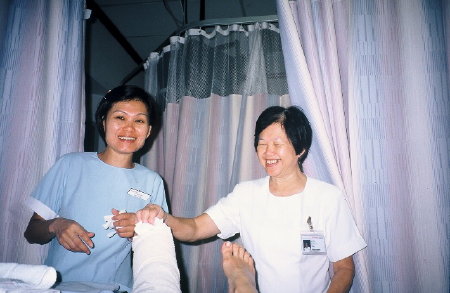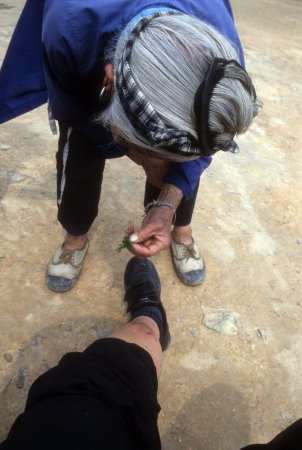I love the preparations for a big trip: considering the itinerary, pouring over guidebooks, talking with others to gain insider tips and organizing my packing. Unfortunately the responsibilities of adult life don’t go away just because we’re stepping away for a period of time. There are several important facets of life that take quite a bit of planning to figure out, including health and finances. I’ll cover health now and finances next time.
CDC

Dorothy Aksamit had surgery for a broken ankle at Glen Eagles Hospital in Singapore (with permission, D Aksamit)
The “go-to”, most reliable, thorough and practical website for all matters having to do with international travel is the Centers for Disease Control (CDC) website. They have an extensive Travelers Health section with everything you need to know, including general tips for how to stay healthy while traveling to country-specific details about what diseases are prevalent in the area and what vaccinations are recommended.
You can go overboard with trying to anticipate every eventuality. For example, I take virtually no routine medications, yet I have a large, and growing, bag of pharmaceuticals that will try to whittle down. I have prescriptions for a wide variety of antibiotics to address any number of possible infections, with back-up medications in case I encounter resistant bacteria, and sleeping pills. I also have a large supply of over the counter products to battle indigestion, diarrhea, inflammation, fever, allergies and colds. The CDC has a comprehensive list of recommendations for a travel health kit.
I got away with minimal vaccinations for this trip because I was up to date with most, leaving only the routine flu shot. Typhoid is endemic to most of the countries we will be visiting in SE Asia, but I received the oral vaccine 3 years ago. It’s good for 5 years so I didn’t need a booster. I’m also up to date with tetanus, Hepatitis A and B vaccines. The CDC recommends that you see your doctor 4-6 weeks before you embark on overseas travel to assure that some of the vaccines have enough lead time to be at their peak effectiveness.
Malaria prophylaxis is a conundrum for many, due to the side effects of some of the medications, anticipating when to take the oral medications, and deciding which medication to take. When we lived overseas we decided against it, but my doctor flipped out when I was too cavalier about it, so I’m lugging a big bottle of pills. Malaria, characterized by fevers, chills, body aches and other symptoms, can range from mild to deadly and is a serious disease. This time I elected to get a prescription for mefloquine (Lariam), which only has to be taken once a week, and I’ll start it before we head to the rural areas, which is where the danger is greater. The CDC has a handy chart with a run-down of the pros and cons of the various approaches. Being a mosquito-borne illness it is also useful to reduce your chances of contracting this debilitating disease by wearing long pants and long sleeves (not appealing in the heat), using mosquito-repellent (love putting potent chemicals on my skin) and sleeping under bed nets (which I tend to get tangled up in).
Traveler’s diarrhea: Food and water
One section of the CDC website you should read if you ever step foot in any country with poor sanitation is the Traveler’s Diarrhea section, which includes an FAQ section and a health care provider write-up that contains more detail. The recommendations on avoiding fresh fruits and vegetables, unless peeled or cooked, as well as avoiding unsafe water, including ice cubes, is probably the most important and effective method of avoiding traveler’s diarrhea. When I hear of people developing diarrhea it usually doesn’t take much questioning to pinpoint the likely cause, often a salad or mixed drink. “But it was at our clean, modern hotel,” is usually the refrain I hear, which is meaningless.
One tip I picked up several years ago from the CDC site is the value of bismuth subsalicylate (Pepto-Bismol) tablets. There is evidence from clinical trials that demonstrate the anti-bacterial properties of this over-the-counter product, so I always have a few in my purse or pocket in case we slip up. The studies used a dose of two tablets 4 times a day. Benign side effects include black tongue and stools, which can be visually unsettling, but are harmless.
Pre-travel: Finding a doctor at home

Dorothy Aksamit has nettle sting treated in a remote village in SW China (with permission, D Aksamit)
I go to my regular doctor, who is familiar with overseas travel needs. I review the CDC information on my own, print relevant information, jot down what I think I’ll need for prescriptions, and then we look at the CDC website together. You should check with your physician to see if s/he carries the vaccines you’ll need, or if they need to order them ahead of your visit.
Another option is to visit a Passport Health clinic, a private chain of clinics in the US that concentrate on providing travel-related health services, if there is one is your area. They are a good option if you don’t have a regular doctor, if your doctor doesn’t handle travel vaccines, or if you need services quickly and can’t get in to see your doctor without a lengthy wait. In the San Francisco Bay Area there are locations in San Francisco, Oakland, San Rafael and Santa Clara. I’ve used them in the past and found them to be very convenient, though there was an extra charge of around $100 for the consultation. They also have a web-based store that sells useful travel supplies, including bed nets and various water purifier products.
Food allergies and medical alerts
If you are allergic to certain foods or drugs, or have a medical condition it is a good idea to prepare in advance. I don’t have any true food allergies but I have developed a sensitivity to MSG, a common additive in Asia cooking. When traveling through Vietnam one time I came across the phrase for how to request “no MSG” and wrote it in my notebook so I could show wait staff. Since then I have discovered Select Wisely cards. These are laminated wallet cards with phrases that can be translated into the language of your choice. I carry one in my wallet so the waiter can take it back to the cook. When I need a language that isn’t on my card I have the receptionist at the hotel help me with a written translation that I tape on the card. There are many stock phrases you can choose from on the Select Wisely website, or you can have a custom card made up for food allergies or other medical conditions. (See my review at Striped Pot)
If you are under a doctor’s care for a medical condition it’s a good idea to carry a current summary of your medical condition and a copy of your latest labs. Old fashioned hard copy is the easiest to provide to a local doctor if you should need medical care abroad, but you could also carry it electronically if you are carrying a laptop or tablet. Another option is to store it in the “cloud” on the internet via a service like SugarSync, which provide 5 GB of free document storage. (See my review on Yahoo)
Finding a doctor overseas
Finding a doctor overseas can be intimidating, especially if you are seriously injured or very ill. The CDC website provides a link to the International Society of Travel Medicine, which provides information about clinics around the world that specialize in travel medicine and have English-speaking staff. The CDC also links to various organizations that provide information on clinics in different countries. Many guidebooks, as well as embassies, can provide suggestions.
In SE Asia, where we will be, conventional wisdom calls for immediate transport to Singapore or Hong Kong, where the medical standards are very high, or a quick flight home to the U.S. in case of serious injury or illness. My mother, Dorothy Aksamit, broke her ankle on a solo trip to Indonesia and followed this course of action. She traveled to Singapore, where she received competent and compassionate care, including surgery and a 6 day stay in the hospital. This would have been an outpatient surgery in the U.S., but not having a caregiver on hand, the multi-day hospital stay was very convenient for her.
Health insurance
Our insurance will cover us overseas, but each policy varies so it’s important to check with your insurance carrier. An extra service we’ve considered is a medical evacuation service offered by Medjet Assist and other companies. Prices are reasonable for short trips ($250/person), but increase rapidly for longer trips, so it’s always a cost/benefit analysis.
In International Travel News, a publication I subscribe to, “the Betty James Travel Insurance Strategy” has become legend. In short, Betty James purchased at $154 “zero trip cost” (post-trip departure coverage only) policy from Travelex for a 2009 cruise in South America. After falling and breaking her hip she was well taken care of, with Travelex arranging every detail of her care, including multiple ambulance trips, medical/surgical services, Learjet emergency evacuation to Chile, a commercial flight from Chile to Florida (including her companion) and limo service to her home. The cost totaled $80,000 ($35,000 for medical care, $45,000 for everything else) and she never saw a single bill! This policy is priced by the day and for a one or two week trip is very reasonable, as Betty James found, but for a long trip like we’re taking would be over $700—not quite as reasonable, but potentially still a bargain.
Summary
In short, the CDC Travel website has pretty much everything you need to guide you through a healthy trip. See your doctor or schedule an appointment at a Passport Health clinic to obtain vaccinations and prophylactic medications for your trip. Hopefully a little bit of planning ahead of time can will ensure that you’ll be traveling problem (and illness) free.